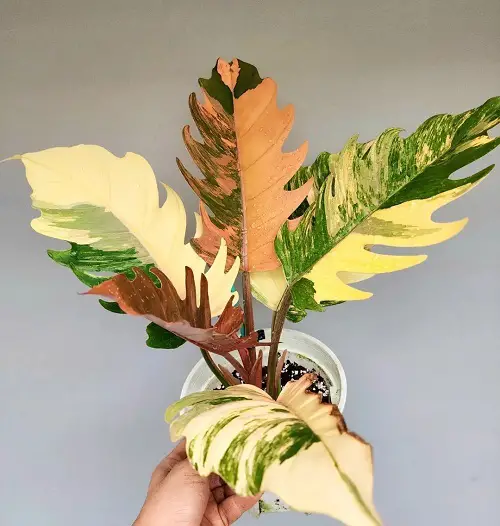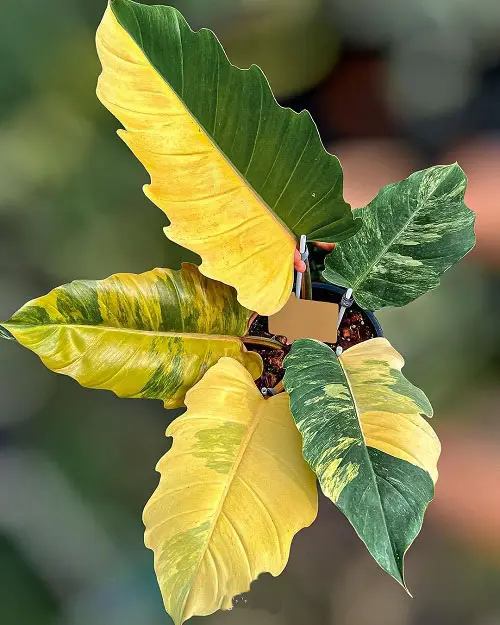Learn the basics of Philodendron Caramel Marble care that will help you grow this magnificent plant easily at home!

This unique plant is an instant attention-grabber. With its large and glossy leaves of multiple extravagant colours, it is a dream of every gardener. This article shall provide with the best tips of Philodendron Caramel Marble Care.
Philodendron Caramel Marble Plant Information
Philodendron Caramel Marble (Philodendron hederaceum ‘Caramel Marble’ or Philodendron x serratum ‘Caramel Marble’) is a visually striking houseplant renowned for its captivating physical features. This rare variety boasts heart-shaped leaves that showcase an exquisite blend of caramel, cream, and green colors, creating a mesmerizing marbled pattern. The glossy leaves have an attractive texture and mature to develop unique markings, making each plant truly distinctive.
With its lush foliage and intricate coloration, the Philodendron Caramel Marble adds an instant touch of elegance and sophistication to any indoor space. It serves as a focal point in home decor, accentuating its surroundings with its eye-catching beauty.
Whether displayed as a cascading vine or a compact bushy plant, it will be a delightful addition that brings a touch of nature’s artistry into your home.
Botanical Name: Philodendron hederaceum or Philodendron x serratum
Common Name: Caramel Marble
Propagating Philodendron Caramel Marble

There are several methods you can use to propagate Philodendron Caramel Marble:
- Stem Cuttings: Take stem cuttings with at least one node and a few leaves. Place the cuttings in water or a well-draining soil mix until roots develop.
- Aerial Layering: Choose a healthy stem and make a small incision or remove a small section of the outer bark. Apply rooting hormone and wrap the area with moist sphagnum moss. Secure it in place with plastic wrap or a twist tie. Once roots develop, cut below the rooted section and plant it.
- Division: If your Philodendron Caramel Marble has multiple stems growing closely together, you can carefully separate the plant into multiple sections. Ensure each division has some roots attached and replant them in separate containers.
- Offsets or Suckers: Philodendron Caramel Marble can produce small plantlets known as offsets or suckers. These can be gently separated from the parent plant and planted in their own pots.
- Leaf Cuttings: While less common, Philodendron Caramel Marble can be propagated from leaf cuttings. Take a healthy leaf and cut it into sections, ensuring each section has a vein. Place the cuttings in a moist soil mix and wait for roots and new growth to emerge.
The best time to propagate Philodendron Caramel Marble is during the active growing season, which is typically in spring or summer.
Best Pot for Philodendron Caramel Marble

You can start the plant in an 8-10 inches pot, which will be good for a few years. After that, depending on the growth and spread of the plant, re-pot it into one size bigger container than the old one.
Here are Plant Pot Sizes from Inches to Gallon
Requirements of Growing Philodendron Caramel Marble

Sunlight
Philodendron Caramel Marble prefers bright, indirect light. It prefers moderate to high levels of light but should be protected from direct sunlight, as it can scorch the leaves.
Place your magnificent plant in a location where it receives bright, filtered light, such as near a north or east-facing window.
Soil
It thrives in well-draining soil that retains moisture without becoming waterlogged. A recommended soil mix consists of a combination of peat moss, perlite, and well-aerated potting soil.
This blend provides a balance of moisture retention and proper drainage, preventing the roots from sitting in excess water. A slightly acidic to neutral pH level (around 6.0-7.0) is ideal for this plant.
Tip: Avoid using heavy clay-based soils that can lead to waterlogged conditions.
Check Out These Soil Recipes For Philodendrons And Monsteras Here!
Water
Proper watering is crucial for the health of Philodendron Caramel Marble. Aim to keep the soil consistently moist but not soggy. Allow the top inch of the soil to dry out before watering again.
Here are the best ways to water plants
Overwatering can lead to root rot, while underwatering can cause the plant to wilt and suffer. It’s recommended to water the plant thoroughly, ensuring water reaches the root zone and allows any excess water to drain away.
Temperature and Humidity
Philodendron Caramel Marble loves average room temperatures ranging from 65-85°F (18-29°C). It prefers a warm and stable environment, avoiding extreme temperature fluctuations. Avoid exposing the plant to cold drafts or placing it near heating vents, as sudden temperature changes can stress the plant and affect its growth.
In terms of humidity, it appreciates moderate to high levels of humidity. It thrives in environments with humidity levels of around 50% or higher. If the air in your home tends to be dry, you can increase humidity by using a humidifier, placing the plant on a pebble tray filled with water, or regularly misting the leaves with water.
Here are 10 Ways To Increase Humidity For Houseplants That Work
Philodendron Caramel Marble Care

Fertilizer
To ensure optimal growth of your Philodendron Caramel Marble, fertilize it with a balanced, water-soluble fertilizer with an NPK ratio of 20-20-20 or a similar formulation.
Dilute the fertilizer according to the package instructions, typically at half the recommended strength, to avoid overfeeding. Apply the diluted fertilizer every 4-6 weeks during the active growing season, which is typically spring through summer.
Learn about the dried banana leaf fertilizer Here!
Pruning
Regular pruning is beneficial for maintaining the health and appearance of Philodendron Caramel Marble. Prune the plant as needed to remove dead, yellowed, or damaged leaves, which helps redirect energy to new growth.
Additionally, you can trim long or leggy stems to encourage a bushier, more compact growth habit. Use clean, sharp pruning shears or scissors to make clean cuts just above a leaf node.
Pruning can be done throughout the year, but it’s best to avoid extensive pruning during the plant’s dormant period in late fall and winter.
Pests and Diseases
Pests such as spider mites, mealybugs, and aphids can infest Philodendron Caramel Marble. These pests feed on the plant’s sap, leading to leaf damage, yellowing, and overall decline. Regularly inspect your plant for signs of infestation, and treat them with appropriate insecticidal soaps or oils to control the pests and prevent further damage.
Philodendron Caramel Marble is susceptible to diseases like root rot and fungal infections. Root rot occurs due to overwatering or poor drainage, leading to waterlogged roots and potential fungal growth.
To prevent root rot, ensure well-draining soil and water the plant only when the top inch of soil is dry. Fungal diseases, such as leaf spot or stem rot, can occur in overly moist conditions.
Maintain proper airflow around the plant and avoid overhead watering to minimize the risk of fungal infections.
Tip: Remove and destroy any infected plant material and consider using a suitable fungicide if necessary to control fungal issues.
Why is Philodendron Caramel Marble So Expensive?
Several factors contribute to the relatively high price of Philodendron Caramel Marble. Firstly, its rarity plays a significant role. Philodendron Caramel Marble is a unique cultivar with stunning foliage, making it a sought-after and highly desirable plant among collectors and enthusiasts.
Limited availability and difficulty in propagation contribute to its scarcity, driving up the price. Additionally, the time and effort required to nurture and grow these plants to a saleable size add to their cost.


